Marc Weidenbaum's Blog, page 235
May 23, 2020
Advice When Sharing Your Music Via Email
Music PR is broken. The awesome ease of email has combined with the awesome ease of self-publishing audio to produce a far-from-awesome spampocalypse of valueless promotional information. These emails flood the inboxes of recipients and occlude the occasional actually useful and valuable email. Below is some advice when sharing your music for promotional purposes via email, some specifics about sending music to this website (disquiet.com), and a somewhat vile but not valueless metaphor:
Part 1: What Not to Do
Don’t expect to hear back.
Don’t send 1,000 words of backstory.
If you put a giant picture of the album cover or the musician(s) at the top of the email, it likely pushes everything “below the fold,” and thus risks the recipient not scrolling down to read what the music is actually like, or clicking on a link to hear it. Don’t do this.
Don’t send a “follow-up” email. Trust that a non-reply is evidence of a lack of interest or lack of time (these aren’t the same thing).
If you don’t describe what the music is like, you risk someone not clicking on a link to hear it.
If you make the music download-only, you risk someone on a phone will never get around to downloading it when they’re back at their laptop. Have a streaming option.
Definitely don’t send a second follow-up email (that is, don’t send a third email).
Feel free to “watermark” your audio files, but don’t be surprised if it decimates the percentage of recipients who elect to pay attention to them.
If you start your email with the recipient’s name, and it’s an automated email to a list, you’re feigning familiarity. That’s unnecessary, and frankly contrary to the intimacy of listening that you’re trying to encourage.
Don’t begin the email with “I love your [blog, magazine, writing]” if you don’t mean it.
Don’t attach audio files. They’re big and slow. Link to them (via Dropbox, etc.).
Part 2: What to Do
Keep the communication brief.
Describe the music.
Provide (briefly) some context for the audio: why, how, when, and/or where you made it.
Provide as many different ways to listen as possible. And put as few obstacles between your email and those links as possible.
Part 3: When Submitting Music to Disquiet.com
When I’ve received way too many emails from a human-seeming email account (not from what’s clearly an automated service aiming for maximizing recipients), I sometimes send back a reply. I have a few variations in a file titled “cut-and-paste.txt” and they get tweaked as time passes. Here’s the one I most frequently send out:
Hi. This isn’t up my alley. Too pop for me.
For context: I focus on ambient music, experimental electronic music, contemporary classical, instrumental hip-hop, sound art, and other vaguely related things, related to the extent that the use of technology feels exploratory, intentional — and I must admit I write about virtually nothing with an intelligible vocal.
I should also mention: I get hundreds of inbound emails about music every weekday, and so I rarely respond. I do listen constantly, and when I find something I want to write about, I write about it. I’m a horrible correspondent.
Part 4: A Somewhat Kafka-esque Conundrum
I’ll put this bit at the end, because it’s gross, and yet informative. When I lived in Brooklyn, before moving to California, home was a nice building that, despite being nice, was popular with the cockroach crowd. There was one bathroom in the apartment I shared with some friends, and it was through the kitchen. If you needed to go to the bathroom in the middle of the night, you had to walk through the kitchen. When you turned the light on, the floor of the kitchen would seem to shudder, and then what was in fact a lot of cockroaches would flee. Which is to say, getting to the email I want to read means, on a daily basis, getting through the cockroach equivalent of email. Don’t be a cockroach.
May 22, 2020
The YouTube Étude (Loop Edition)
A lot of YouTube videos of music (in contrast with “music videos,” a term that brings to mind a dramatized or play-along format, à la classic-era MTV) focus on specific instruments. These can feel salesy, and given the prevalence of affiliate links might even be salesy, but many of them are simply evidence of musicians focused on their tools. Some are about trying out new things, while others are about dedication to a thing. Many of the musicians who make these videos are experts in their craft, and their videos are the études of streaming life. Such is the work of Amulets (aka Randall Taylor), whose tool of choice is the tape loop. He is a prolific utilizer of loops, and an activist in promoting their utility (his how-to video is approaching 150,000 views). His latest, posted this morning, is a timely one, a roughly nine-second loop, seen rotating in plain view, as a warped vocal goes round and round. The table on which the player-recorder rests is festooned with the little plastic reels of past and, no doubt, future experiments. In a brief accompanying note, Taylor connects the maudlin yet beautiful sound to our current circumstances:
I just had this super simple video idea and decided to make it in quarantine. It’s really nothing more than a repeating tape loop, but I think it’s definitely a reflection of the monotony of quarantine life and our daily existence. These days are on loop and no one really knows when its going to end…
This is the latest video I’ve added to my YouTube playlist of recommended fine live performances of ambient music. Video originally posted at youtube.com. More from Taylor at amuletsmusic.com.
May 21, 2020
Disquiet Junto Project 0438: Deep Plan

Each Thursday in the Disquiet Junto group, a new compositional challenge is set before the group’s members, who then have just over four days to upload a track in response to the assignment. Membership in the Junto is open: just join and participate. (A SoundCloud account is helpful but not required.) There’s no pressure to do every project. It’s weekly so that you know it’s there, every Thursday through Monday, when you have the time.
Deadline: This project’s deadline is Monday, May 25, 2020, at 11:59pm (that is, just before midnight) wherever you are. It was posted on Thursday, May 21, 2020.
These are the instructions that went out to the group’s email list (at tinyletter.com/disquiet-junto):
Disquiet Junto Project 0438: Deep Plan
The Assignment: Compose a piece of music in which something special is situated at the very center.
Step 1: There is just one step this week: Compose a piece of music in which something special is situated at the very center.
Background: You might simply interpret that instruction as you choose to. For additional context, you might consider this centerpiece a surprise, or you might hint at it at the opening. It might be a gap, or a presence, or something in between.
Seven More Important Steps When Your Track Is Done:
Step 1: Include “disquiet0438” (no spaces or quotation marks) in the name of your tracks.
Step 2: If your audio-hosting platform allows for tags, be sure to also include the project tag “disquiet0438” (no spaces or quotation marks). If you’re posting on SoundCloud in particular, this is essential to subsequent location of tracks for the creation of a project playlist.
Step 3: Upload your tracks. It is helpful but not essential that you use SoundCloud to host your tracks.
Step 4: Post your tracks in the following discussion thread at llllllll.co:
https://llllllll.co/t/disquiet-junto-project-0438-deep-plan/
Step 5: Annotate your tracks with a brief explanation of your approach and process.
Step 6: If posting on social media, please consider using the hashtag #disquietjunto so fellow participants are more likely to locate your communication.
Step 7: Then listen to and comment on tracks uploaded by your fellow Disquiet Junto participants.
Additional Details:
Deadline: This project’s deadline is Monday, May 25, 2020, at 11:59pm (that is, just before midnight) wherever you are. It was posted on Thursday, May 21, 2020.
Length: The length is up to you. This may be the rare circumstance when longer is better.
Title/Tag: When posting your tracks, please include “disquiet0438” in the title of the tracks, and where applicable (on SoundCloud, for example) as a tag.
Upload: When participating in this project, be sure to include a description of your process in planning, composing, and recording it. This description is an essential element of the communicative process inherent in the Disquiet Junto. Photos, video, and lists of equipment are always appreciated.
Download: Given the nature of this particular project sequence, it is best to set your track as downloadable and allowing for attributed remixing (i.e., a Creative Commons license permitting non-commercial sharing with attribution, allowing for derivatives).
For context, when posting the track online, please be sure to include this following information:
More on this 438th weekly Disquiet Junto project, Disquiet Junto Project 0438: Deep Plan — The Assignment: Compose a piece of music in which something special is situated at the very center — at:
More on the Disquiet Junto at:
Subscribe to project announcements here:
http://tinyletter.com/disquiet-junto/
Project discussion takes place on llllllll.co:
https://llllllll.co/t/disquiet-junto-project-0438-deep-plan/
There’s also a Disquiet Junto Slack. Send your email address to twitter.com/disquiet for Slack inclusion.
Image associated with this track is from NASA, used thanks to a Creative Commons license and Flickr. The image has been cropped, colors shifted, and text added.
May 20, 2020
This Week (off) in Sound
There was no This Week in Sound email newsletter (tinyletter.com/disquiet) this week. The last class session of the 15-week semester of Sounds of Brands (Quarantine Remix feat. Zoom), the course I teach once a year, occurred today. These two statements are related.
Paper Music
The semi-bad news is I spent a considerable amount of time a year or so ago researching how people notate their synthesizer patches, never coming to a conclusion that I felt was (yet) substantial enough to write about. That is, how they draw, or photograph, or otherwise annotate for future reference the combination of cables and knobs, sliders and (increasingly) menu settings of their modules.
The not unrelated good news is, having done that work, I had developed some fledgling ideas as to how to accomplish such a task, ideas I drew upon this evening when my camera failed to record audio for what would have been the day’s Buddha Machine Variation.
The second of the images below is how I transcribed some menu settings (on the ER-301 module, using the Feedback Looper unit). I was, apparently, especially (presciently?) primed to take these notes, because the first of these two images is something I wrote in a notebook last night when an idea for today’s patch first suggested itself. So, these are the before and after. What’s missing is the middle, the actual recording.

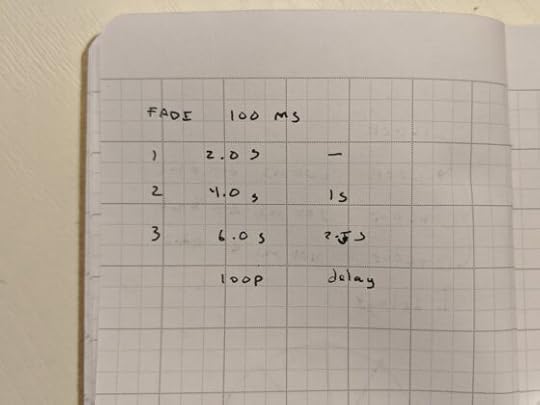
May 19, 2020
Buddha Machine Variations No. 35 (Tripled Suite)
This was an experiment in exploring the device as a whole: not just as a set of loops contained in one object, but the sequence of those loops, and the way the loops progress as a result of the object’s design. All the previous Buddha Machine Variations to date have involved one loop per machine. Here the multiple loops of such a device, one from the second-generation of Buddha Machines, are heard not just in sequence, but in overlapping sequences. They’re considered as a suite.
There are three subsets of whatever loop is playing at a given time. Each is a subloop: one three seconds, one four seconds, one five (in the ER-301 module, using the Feedback Looper unit). Each of the subloops is extracted from a different narrow band of the audio spectrum (via the FDXf module). As the piece proceeds, the button on the side of the Buddha Machine is clicked. One or more of the subloops begins recording the new audio almost immediately, but there is some time before the preceding loop is entirely eradicated. At the very end, the audio cable is pulled out of the Buddha Machine, and eventually all the subloops give way to silence. (This was less sudden when rehearsed, but it works OK here. I’ll be trying this all again with a slightly different approach.)
For further patch-documentation purposes, here is a shot of the synthesizer:
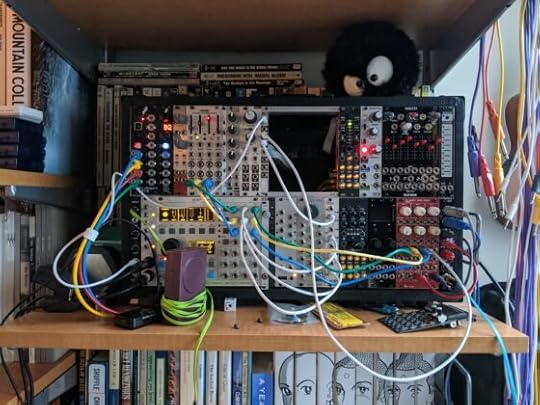
Video originally posted at youtube.com/disquiet. There’s also a video playlist of the Buddha Machine Variations.
May 18, 2020
Buddha Machine Variations No. 34 (Chamber Refraction)
One loop from the fifth generation Buddha Machine, little snatches of it glitching out in a semblance of correlation. At first all that’s heard is the unaltered audio of the source loop. That’s the fifth channel of the mixer (lavender cable). And then one by one, the first through fourth channels of the mixer are introduced. Each is set on a mico-looping procedure of the source loop, varying individually between roughly 100 and 300 milliseconds. They are each set to record over whatever was there before, meaning sometimes there will be silences. And finally, once the main source audio is turned off in the mix (at 1:45), all that is heard is this combination of microloops.
If you’re familiar with the ER-301 module, here’s some additional detail: The unit being used is the Feedback Looper. There are four of these running individually. Each is taking a square wave from the Batumi as its on/off switch to record. In addition, each is taking the next channel’s on/off as its trigger to (un)engage (the fourth channel looks to the first channel, squaring the circle).
That runs for quite awhile, and then at 2:55 the relative pace of the four square waves are altered. This has an impact on when the individual loopers are triggered, and then at 3:09 the Batumi is switched from “free” mode to “quad,” and the levers adjusted further.
For further patch-documentation purposes, here is a shot of the synthesizer:
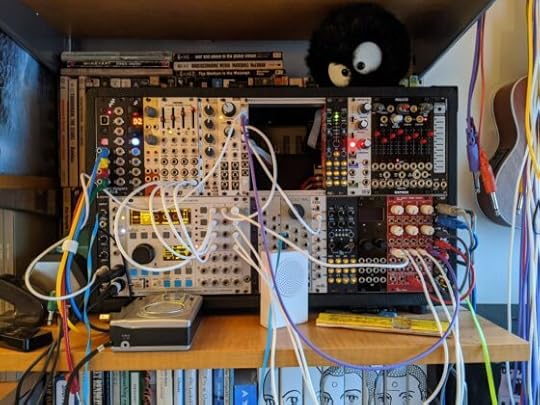
Video originally posted at youtube.com/disquiet. There’s also a video playlist of the Buddha Machine Variations.
May 17, 2020
Current Listens: Electroacoustic Mellotron + Double Bass
This is my weekly(ish) answer to the question “What have you been listening to lately?” It’s lightly annotated because I don’t like re-posting material without providing some context. In the interest of conversation, let me know what you’re listening to in the comments below. Just please don’t promote your own work (or that of your label/client). This isn’t the right venue. (Just use email.)
▰ ▰ ▰ ▰ ▰ ▰ ▰ ▰ ▰ ▰ ▰ ▰ ▰ ▰ ▰
NEW: Recent(ish) arrivals and pre-releases
▰ The always exciting Madeleine Cocolas is back with a new full-length, Ithaca (Room40), filled with percolating, emotional music. The compositions blend elements that folks who listen to techno and classical minimalism might think of as their own, and will learn they have to share nicely with others. A standout is the stately “The Heart Doesn’t Lie (Except When It Does),” a slow solo piano work that is generous with its pauses.
▰ A who’s who of experimental musicians from the San Francisco Bay Area collaborated with Tim Walters on Shatter in Place, a fundraiser for Bay Area Safety Net (“a non-profit designed to help support artists in the Bay Area during the COVID-19 crisis”). A highlight is “Multiplication Street,” which makes the foment of Lisa Mezzacappa’s double bass available, as with all the other contributions, to serve as “electroacoustic source material” for Walters’ artfully mercurial transformations. The other contributors are Myles Boisen, Kyle Bruckmann, Brett Carson, Tom Djll, gabby fluke-mogul, Phillip Greenlief, and Gino Robair.
Shatter in Place by Tim Walters
▰ “Adagio for Mellotron and Modular Synthesizer,” at once both patient and tensile, features the latter by itwasthewires and the former by Marco Lucchi. Lucchi’s collaborations have been a highlight of my SoundCloud stream lately.
▰ A single-instrument performance on a sampler is never truly a single-instrument performance, not when you consider what was sampled. In the case of r beny’s lush, dreamy “Vestals,” this includes piano, strings, and synthesizer material. The video was recorded live for Do It Yourself, Together, a streaming festival put together by Synthstrom Audible, the company that makes the Deluge, the instrument he’s playing. Synthstrom was supposed to have some concerts (live, in person — remember those?) back in March, where every performer would just use the Deluge. They were, of course, cancelled due to the current circumstances. I was really looking forward to one scheduled for March 21 in Oakland, California, across the Bay from where I live, but it didn’t happen. R beny was among those scheduled to perform that evening.
▰ The new weekly Robert Fripp series of quiet instrumental tracks each come out at what seems to be 2am if you live in California, which is a more humane 10am in England. The gorgeous third entry, recorded back in 2006, was released this past week. Somehow his account still has under 8,000 subscribers.
Buddha Machine Variations No. 33 (Fragmentary Occlusion)
One loop from the first generation of the Buddha Machine, which turns 15 years old in 2020. The loop ends up with three variants in the mixer, channels one, two, and five. The fifth channel (lavender cable) is just the straight audio out of the Buddha Machine (a little noisier than usual, perhaps because the batteries were going). The first channel is the output of the Muxlicer, which switches between eight variants on the audio: six are spectral bands (from the FXDf), and two are channels of the granular synth (the position of which, in the Smog, is shifting regularly). The Muxlicer is going at a steady pace (clocked by the Dixie II, starting when the Muxlicer’s switch is flipped at :28), but the sequence is random thanks to an inbound sine wave (from the Batumi). The second channel, which kicks in at 3:24, is a tiny fragment of a loop that is constantly being overwritten, and it’s set off from the Muxlicer’s beat by a slight, almost half-second delay, which at first gives the contrast a sing-song quality, but eventually disappears as the amassed swell occludes virtually everything. And that’s about it, except that at 4:25 a slow wave is introduced to gently alter the volume of the original, channel-five track.
For further patch-documentation purposes, here two shots of the synthesizer:
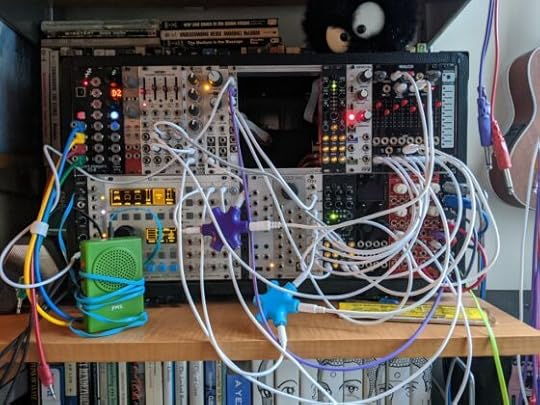
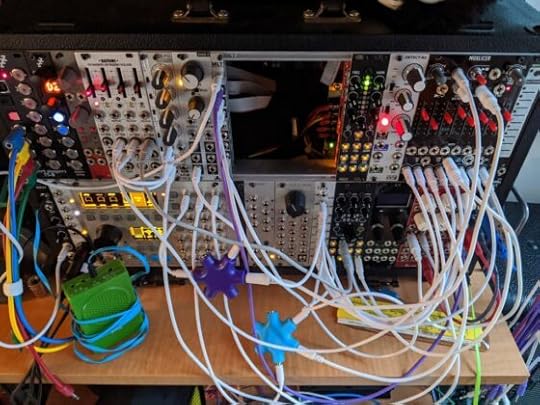
Video originally posted at youtube.com/disquiet. There’s also a video playlist of the Buddha Machine Variations.
May 16, 2020
Buddha Machine Variations No. 32 (Microloop Trial)
This is a Saturday evening trial run at selecting tiny bits of a single loop from a Buddha Machine and having them pulse against each other. Eventually the main source line is eliminated so that only these microloops remain. Toward the end, two of the microloops are further affected by delays that warble by changing ever so slightly within a narrow range at a rapid pace. There’s not much more to it than that. The source audio is the third generation of Buddha Machine, called Chan Fang, which came out a decade ago, back in 2010. The instrument heard is the qin, a Chinese zither.
There are five channels into the mixer. The purple one, channel five, is the unadulterated source audio. Channels one through four each get their own individual micoloop in real time, one at a time. Channels three and four are the ones eventually set to warble (channel four starting at 3:24, channel three at 4:52). The loops and delays occur in the ER-301 (the large synthesizer module in the lower left, running the Pedal Looper and Delay units). The warble is a result of a pair of waves that come from a combination of the Batumi (the one with four vertical levers directly above the ER-301) and the S.P.O. (the one with four black knobs, two to the right of the Batumi). I’m going to explore this approach further, likely combining microloops from various loops of the Chan Fang.
For further patch-documentation purposes, here is a straight-on shot of the synthesizer:
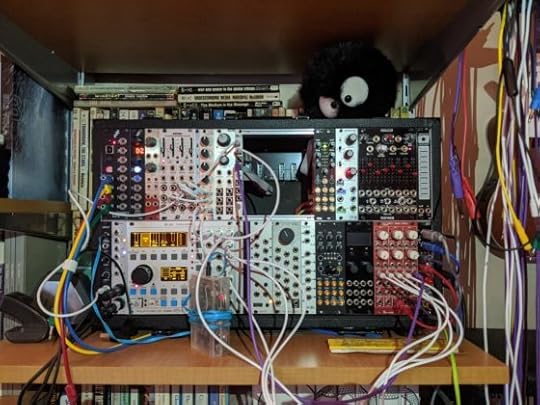
Video originally posted at youtube.com/disquiet. There’s also a video playlist of the Buddha Machine Variations.



